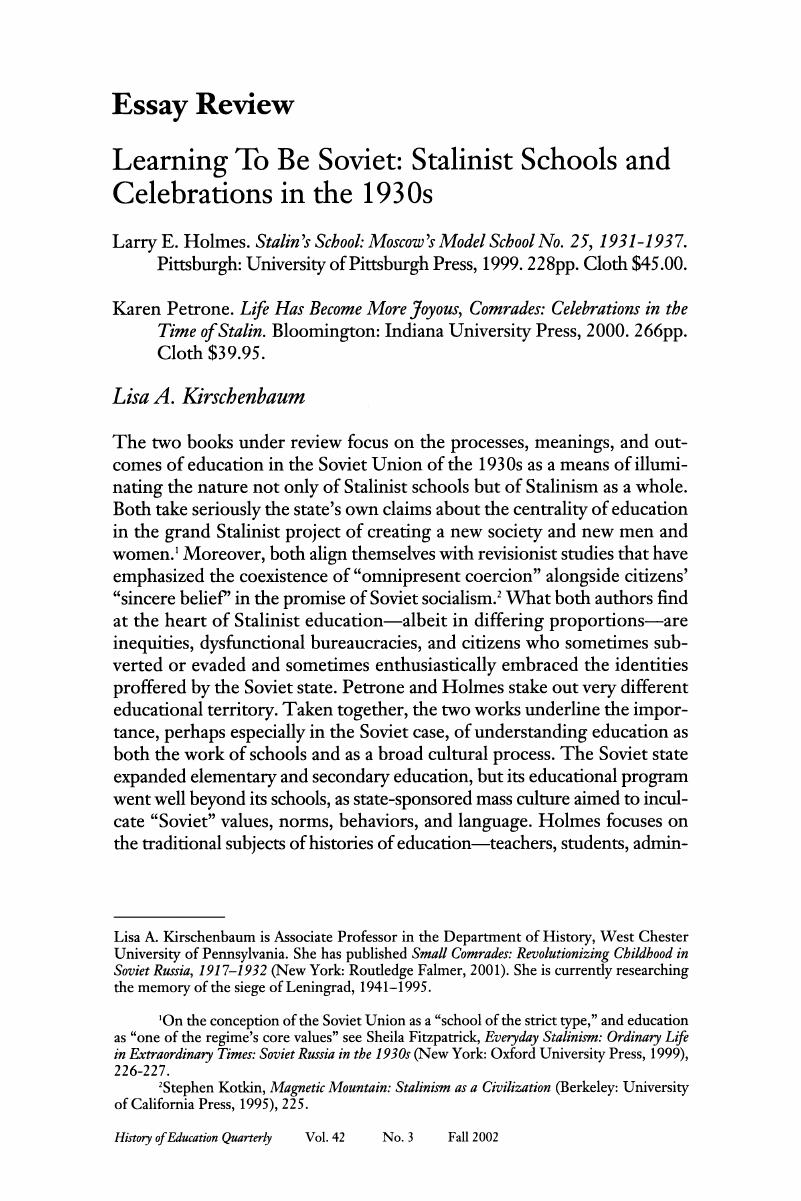Published online by Cambridge University Press: 24 February 2017

1 On the conception of the Soviet Union as a “school of the strict type,” and education as “one of the regime's core values” see Fitzpatrick, Sheila Everyday Stalinism: Ordinary Life in Extraordinary Times: Soviet Russia in the 1930s (New York: Oxford University Press, 1999), 226–227.Google Scholar
2 Kotkin, Stephen Magnetic Mountain: Stalinism as a Civilization (Berkeley: University of California Press, 1995), 225.Google Scholar
3 Getty, J. Arch Origins of the Great Purges: The Soviet Communist Party Reconsidered, 1933-1938 (Cambridge: Cambridge University Press, 1985). Lewin, Moshe “Russia/USSR in Historical Motion: An Essay in Interpretation,” Russian Review 50 (1991): 249-66.Google Scholar
4 Fitzpatrick, Sheila Education and Social Mobility in the Soviet Union, 1921-1934, (Cambridge: Cambridge University Press, 1979), 209–223.Google Scholar
5 Holmes, Stalin's School, 53–54. On resistance to progressive programs in the 1920s see Holmes, Larry The Kremlin and the Schoolhouse: Reforming Education in Soviet Russia, 1917-1931 (Bloomington: Indiana University Press, 1991), 36–55.Google Scholar
6 Brickman, William W. and Zepper, John T. Russian and Soviet Education, 1731-1989: A Multilingual Annotated Bibliography (New York: Garland, 1992), 34.Google Scholar
7 Ewing, E. Thomas “Restoring Teachers to Their Rights: Soviet Education and the 1936 Denunciation of Pedology“ History of Education Quarterly 41 (Winter 2001): 471–493 provides a nuanced account of the relationships between teachers’ “professional aspirations” and the “requirements of the regime” (493).CrossRefGoogle Scholar
8 Shleger, Luiza one of the important progressive opponents of School No. 25, was deeply involved in preschool education. See my Small Comrades: Revolutionizing Childhood in Soviet Russia, 1917-1932 (New York: Routledge Falmer, 2001).Google Scholar
9 Petrone concludes, somewhat speculatively, that celebrations that “emphasized politics” (95) did so in order to provide “special privileges and special indoctrination” (97) to the children of the elite. She explains the different descriptions of the same event as evidence that officiais from the Commissariat of Education and organizers from the trade union “each highlighted the aspects of the celebration that would be most helpful in promoting their ideals or careers” (98). The “or” here is quite critical—by 1936 an unwillingness to rank political indoctrination above creativity was unlikely to aid a teacher's career.Google Scholar
10 Fitzpatrick, Everyday Stalinism, 37.Google Scholar
11 Bonnell, Victoria “The Iconography of the Worker in Soviet Political Art“ in Making Workers Soviet: Power, Class, and Identity, ed. Siegelbaum, Lewis and Suny, Ronald Grigor (Ithaca, NY: Cornell University Press, 1994), 366.Google Scholar
12 Holmes borrows the phrase from Kotkin, Magnetic Mountain, 229.Google Scholar
13 For a discussion of reactions to arrests see Holmes, Stalin's School, 98–99. In Everyday Stalinism Fitzpatrick notes that “the arrest of a family member changed everything overnight” (212), but Holmes's interviewees do not seem to confirm this generalization.Google Scholar